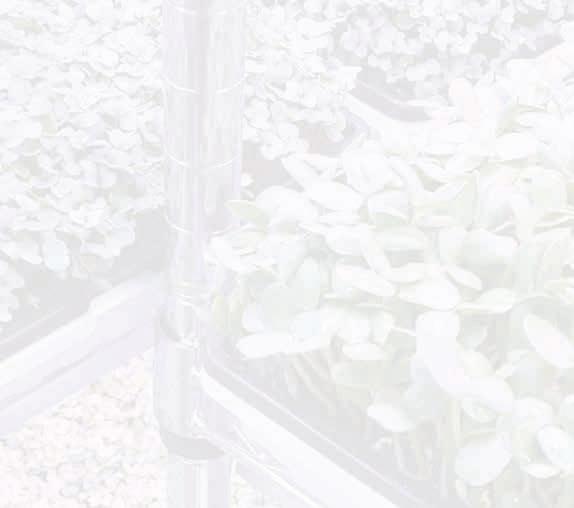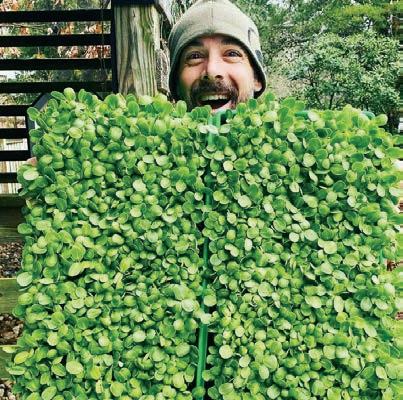
5 minute read
Microgreens pack mega nutrition
please), and any additional tackle desired. No fishing license is required – Heerman’s NC For Hire Fishing Vessel license covers all customers.
Heerman can take a fishing group of up to four people. For those interested in an adventure tour for sightseeing, he can take up to six passengers. His goal is to make sure his clients have a good time, for any type of trip they desire. From seasoned fishermen to those giving it a try for the first time to families with special needs children, he will do everything he can to ensure it’s the highlight of their Outer Banks visit.
For Heerman, what makes a great captain is someone who knows the fish they’re going after, who will make sure the fishing party is safe and has a great time, and who doesn’t want the charter to end. “I have a real honest desire to make them happy. I want them to learn, and tBook a trip with Flying Fish Charters OBX on Facebook, look through great catches on Instagram, call Captain Hank Heerman directly at (252) 455-7522 or visit flyingfishcharters.net.
Courtesy Flying Fish Charters
Conner Heermann from Mechanicsville, Va. and Nate Johnson of Kill Devil Hills with a wahoo and nice catch of dolphin.


24-HOUR ACCESS AVAILABLE!
You Need a YMCA Vacation Pass
Learn more at ymcashr.org/vacation-pass
Daily and 10-day vacation pass options available














Microgreens pack mega nutrition




Courtesy Harrison Microgreens
Brett Harrison grows mega-nutritious microgreens for local customers.
Tucked behind an ordinary Nags Head house is perhaps the tiniest farm in the county, Harrison Farms Microgreens. Microgreens – not to be confused with sprouts – are tiny plants, harvested after the first set of leaves have developed, usually 7 to 21 days. They’re jam-packed with vitamins and antioxidants and can be up to 40 times more nutritious than adult plants. Harrison Farms Microgreens got its start when owner Brett Harrison got tired of buying bagged salad at the grocery store, only to bring it home and it find slimy and smelly. “Nutrient decay starts happening the moment you cut a plant. It’s much more nutritious to buy produce on a local scale,” he said.
He had always enjoyed gardening. “We try to grow our own food,” he said. “But sometimes you spend all this energy and it burns up or you end up with 200 cucumbers.” So he started researching microgreens. “I like systems. I liked the idea that I could make this controlled environment that would consistently provide all year if we wanted.” He started experimenting with the greens and sharing them with friends and neighbors. It wasn’t long before friends were asking for more.
Harrison Farms grows sunflower, red radish, broccoli, kale, red cabbage, arugula, basil, cilantro, nasturtium and amaranth microgreens, and pea shoots. Though the farm is not USDA certified organic, he uses all organic soil and follows practices consistent with an organic farm. Harvesting microgreens is catching the plant is in its sweet spot – the leaves are tender and flavorful, and they are packed full of nutrients and antioxidants. And the taste? “My five- and six-year-old clients love them,” laughed Harrison.
So what can you use these tiny greens on? Apparently, just about everything. “They taste amazing!” said Harrison. Popular uses are on eggs, sandwiches, tacos, avocado toast, cream cheese bagels, soups, and pasta. “You can put them on every meal. They make your meal look and feel special, like you’re at a fancy restaurant,” said Harrison. His favorite are the basil microgreens on a homemade sourdough pizza. “Oh my gosh they’re so good. It’s like everything you ever dreamed basil would be,” he said. Don’t have time for homemade pizza? “Even buy a local pizza and throw some on there,” he said.
The sunflower microgreens are great in smoothies – “they give you so much nutrition,” Harrison said, who has so much energy it’s obvious he’s been eating his greens.
The company’s Facebook page has a dozen pictures of ordinary foods like fried eggs and pinto beans transformed into restaurant-worthy presentations by a sprinkling of microgreens.
But microgreens don’t just add visual appeal. “When I eat them I can tell it’s benefiting my system. I definitely have more energy,” said Elizabeth Bradley, who has worked at the farm since April 2021 and does much of planting and harvesting.
The process for growing microgreens is quick and repetitive. “We joke that it’s like Groundhog Week,” Harrison said. Bradley plants densely layered seeds in trays of organic soil. Within a couple days, the seeds have sprouted and they are moved under the grow lights in Harrison’s small greenhouse. The greenhouse is kept at in the mid 70s and is equipped with a heater, an air conditioner and a dehumidifier. A fan blowing constantly keeps mold (which is all around us) from settling onto the greens.
Bradley keeps the plants moist as they grow a total of two to three inches, depending on the variety. Wednesday is harvest day when the microgreens are cut, washed, dried,




by Summer Stevens










